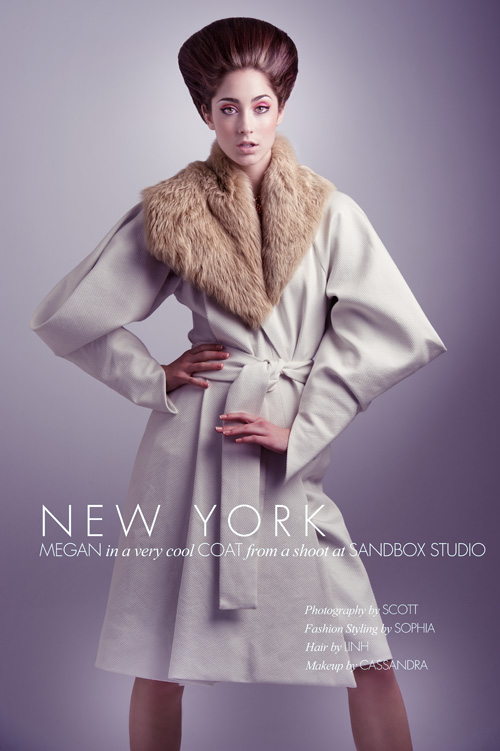
Yesterday our lighting set-up was pretty much for head shots (one beauty dish and a reflector), but for every look we did during the day, I also shot more traditional full length shots as well, but like always—I try to keep the lighting simple, using just one main light. This was shot with a gray background—I added the violet Split Tone effect in the shadow areas inside of Lightroom.
Here’s the lighting set-up for the shot you see at the top of the page. We used the same exact strobe (the Elinchrom BXRI 500), but we switched out the Beauty Dish we used for the headshots shown in yesterday’s post for the 53″ Midi Octa softbox, which is probably my most-often used softbox when shooting fashion (It’s priced fairly decent for its large size—B&H Photo has it $289. Link). The main reason I switched was because I knew I’d be shooting 3/4 length and full length shots, so I wanted the light to cover more area. Also, to make sure some of the main light bounces back toward our subject, we put up a large white V-flat on the opposite side of the Main Light to fill in the other side.
Since I was shooting tethered, positioning the single Main Light was easy—it was controlling the light on the white cove in the background that kept us busy during the day. We would change between a medium gray, light gray, and solid white for most every look, and when you’re using two lights (one lighting each side of the cove) you’re constantly having to mess with the lights to balance them (for dark gray, we’d turn off the lights; for light gray we’d put them on low power, and for solid white we’d crank them up).
Above: Here’s what you have to do when shooting full length shots to get the right look and perspective (I know—it’s not a pretty view of me so stop snickering. But that’s what ya gotta do to get the right perspective). Although this is Tanja in the shot (rather than Megan), I thought I’d at least show you how far back you need to be to shoot at 150mm to 200mm, and precisely how uncomfortable you need to be, which is plenty by the way.
Above: When I was back on my feet again, I moved in as close as my 70-200mm would focus to get this beauty-style shot. You can see the Midi Octa reflected in her eyes. Mmmmm. Midi Octa. I wanted to make sure her eyes were tack sharp, so I put the camera on a tripod before taking the shot.
Above: Since Sandbox Studio is a daylight studio, I wanted to shoot at least one look with natural light, but for this one I thought I’d try something different. I bought a backdrop that looks like the material from a tufted leather couch from Backdrop Outlet (link), and we hung it on a poll between two C-stands. What I wanted to try was to frame the shot so you see the entire backdrop, stands and all (like you see here), but to make it look more like a finished shot (and not a production shot), I laid down on the ground to shoot it like a regular full length fashion shot, and I got the image you see above.
Since I was shooting natural window night, I switched my camera to Aperture Priority mode, and set my f/stop at f/2.8 to get plenty of light into the scene. My shutter speed looked kind of slow at ISO 200, and I was afraid I’d wind up with some blurry shots not being on a tripod down so low, so I increased my ISO to 500 (there’s an ISO you don’t see everyday), and I was up to 1/1600 of a second, and good to go.
Above: After I got the full length, I stood back up and went into for some head and shoulders type of shots. Still using just Natural window light, and the same settings as the full length shot except I lowered the ISO to 400.
Above: Here’s the production shot (photo by Brad Moore), and as you can see, there’s not much going on here—-just natural light. It doesn’t get much simpler than this. By the way; I quickly figured out which window was the North-facing window by using my iPhone’s Compass App. First time I ever needed to use it.
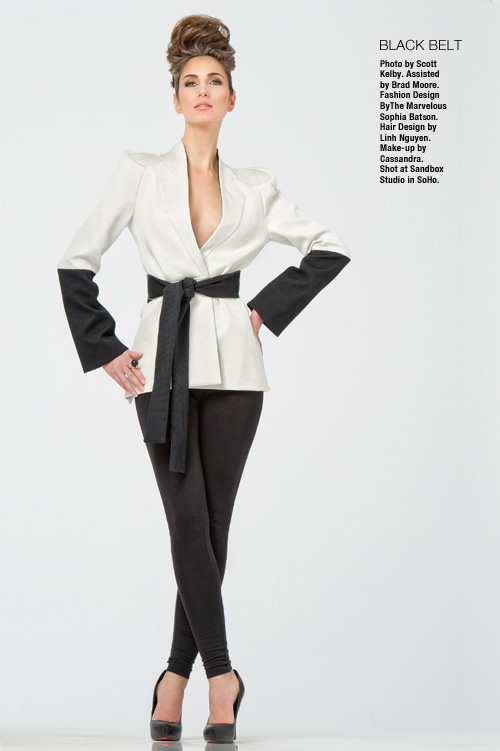
Above: Here’s a full length shot of Tanja (the reflection on the floor is faked in Photoshop. Please don’t tell any one).
Above: Here’s a production shot (photo by Brad Moore). Again, it’s just one Main Light with the 53″ Midi Octa, and then two large V-flat reflectors to bounce some of the light back onto our subject. There are two lights just aiming at the background, but they’re powered down low to create a very light gray, almost off-white background.
Above: Here’s a different perspective from Brad, and you can see the background lights and the V-flats pretty clearly here (and the creative team all looking on during the shoot. While I’m shooting, they’ll quickly jump in and fix hair, adjust clothing, or touch up make-up as we go, which is incredibly helpful).
(Above: some unretouched frames from that set, shown in Lightroom’s Grid View)
Well, that’s it for this one, gang
I hope you enjoyed this behind the scenes look. Thanks to my photo assistant Brad Moore for helping throughout the planning and staging of the shoot; to Megan and Tanja for being so patient and keeping a wonderful attitude the entire shoot, and to Sopha, Linh, and Cassandra for all their hard work in making the shoot a success.



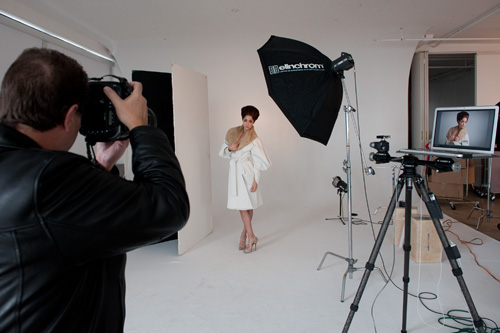
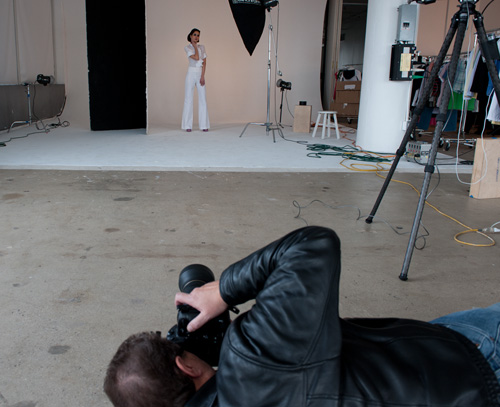
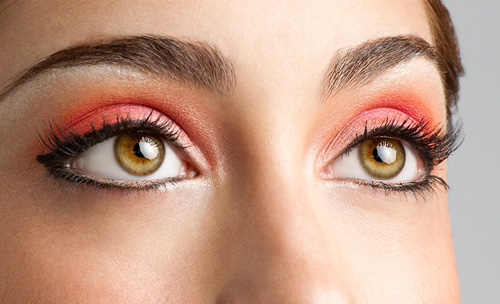
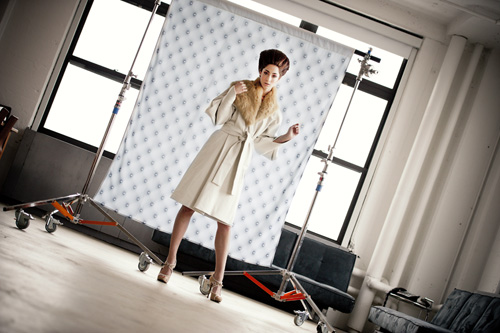
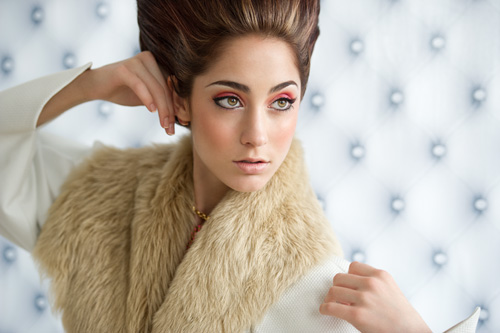
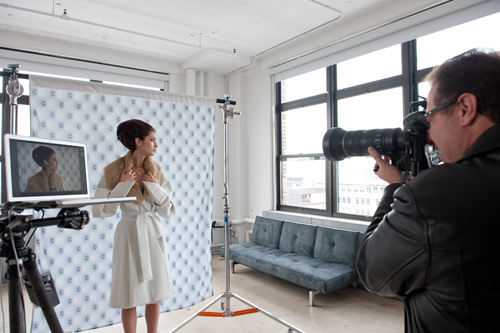
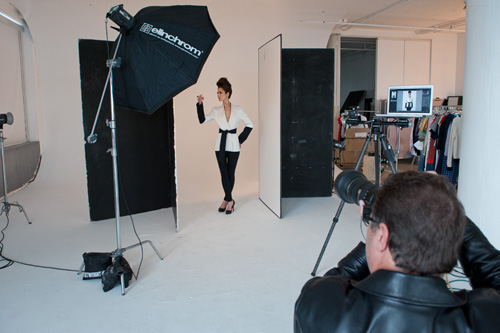
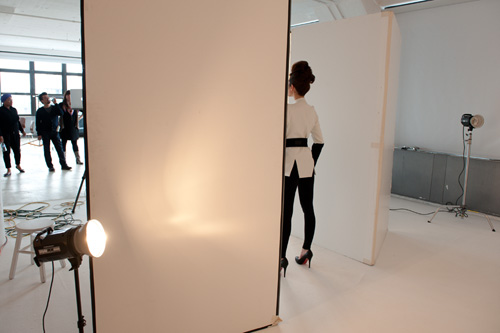
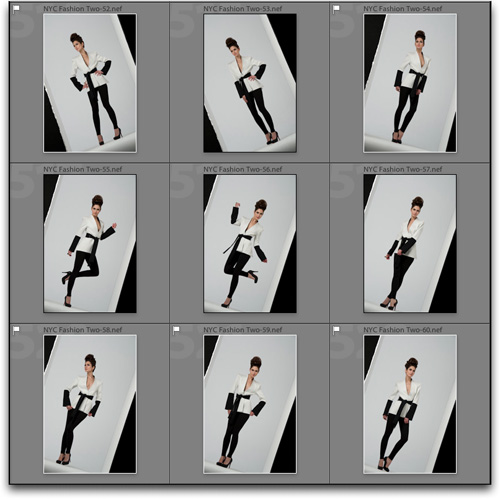
Scott, really CAKB stuff here. I upgraded computers and went to bed early wore out from installing stuff to wake up just when you posted. When is the Recipes 2 book going to come out as an App?
KTzzzzz
Ken: It’s 2:10 in the morning. Go go bed!
-Scott
BAHAHAHA
Ken sends me Twitter messages at 2:10 in the morning and wonders why I’m not awake to reply.
Alight you too, I’ll deal with y’all in Vegas! :)
Excellent posts these past two days, Scott! Very insightful. Not to mention very beautiful models (terrific make-up, btw)! A shout-out to Brad for his pics, as well. Nice to see what the photographer is doing during a shoot and where he is setting up (hope the floor wasn’t too cold, Scott!).
Scott, one thing I haven’t seen mentioned is what cable you use to actually tether to the computer. Obviously an HDMI cable, but how long of a cable do you recommend? Any specific brand? And do you use anything to keep the cable from getting pulled out of the camera or computer accidently? Thanks in advance!
–John
P.S. Did I stay up later than Mr. Toney today? :D
Guess not…………….. :)
John, what are you thinking?… I was asleep, woke up at 2:01, no new blog. Then tried again and the new blog was up! That’s ESP. :)
Hi John:
It’s just a USB cable. I’ll have to have Brad chime in on the exact length, but there’s a short cable, then a USB extension cable that’s much longer, so the two together are pretty long—probably at least 12 to 15 feet is my guess.
Also, at least once or twice a shoot, I step on the cable and yank it out of the camera. The laptop is attached to the laptop using black gaffers tape, so it’s not going anywhere, so the other end (in the camera) is free to just pop right out (and it does).
Hope that helps. :)
-Scott
P.S. Go to bed. It’s 2:17 am for gosh sakes. You don’t see up at all hours like this. ;-)
Scott:
Thanks for the info. I meant to type USB cable, but I must have had HDMI on my mind. I did some research and found a product called “Jerk Stopper” made by Tether Tools. It’s available from Adorama (couldn’t find it at B & H). It’s a strap that attaches to your camera and holds the USB cable loosely, but doesn’t allow it to come out if pulled too tight. About $17. Here’s a link: http://www.adorama.com/TTJS020.html
Might qualify for a Cheap Shot if it saves damage to your camera’s USB port!
–John
Hey John,
Here’s the exact 16′ USB booster cable we use – http://bit.ly/fdUmsK
We just plug the regular USB cable that comes with the camera into it (along with some gaffers tape around the connection to make sure it doesn’t come loose). This works better than a regular extension cable because the signal gets weaker the longer the cable is. This one has the built-in booster so it keeps the signal strong. Hope that helps!
Thanks for the info, Brad! Not too expensive, either!
–John
Thank goodness for the Elinchrom Skyports or I would have 2 wires to contend with. I have 2 USB cables taped together but I have yanked it out of camera a couple of times. I have it rubber band to my Really Right Stuff L plate as it comes out of camera.
Thought I’d chime in since John found one of our JerkStoppers on Adorama. We created the JerkStopper Tethering Kit to avoid cables dis-lodging from both the computer and the camera. Moving around the tethering set up and yanking on the cables is inevitable, so protecting equipment is key. The Kit includes a cable retention device for both your camera and computer. You can check out the full line of options at http://tinyurl.com/2bffjz2. Both McNally and Doorhof are using them and are relying less and less on gaff tape in their tethering set up.
Happy to answer any questions you may have. Thanks.
Surely it’s better to leave the usb to usb join loose to pull apart, and use a jerk-arresting strap to prevent snags snatching at that oh-so expensive mini-usb port on the camera?
Black Box made me powered USB cables – they are 16′ each and you can plug up to 4 together along with the camera USB shorty – I have two so 32′ plus the Nikon cable – works great and lets me move around really easily.
The powered part keeps the signal strong –
All is good.
If the cable does pull loose and you lose your connection to the computer, doesn’t it crash your session? Thought Scott or someone blogged about tethering in Lightroom 3 and mentioned that, along with how it won’t backup to your memory card when shooting tethered… the thought of losing hours’ worth of work is why I’ve been scared to try it. Is this true, or have I just been reading too many blogs at 2am myself? :)
Great post Scott! Long time reader but first time commenter. I liked how you showed the need to be at a lower shooting angle when doing the full length shot. I instantly see it in the photo after seeing the production shot of you laying down but didn’t notice before. I was wondering if for in tight beauty shots if you prefer to shoot the model straight on or from a slightly higher angle? Seems the higher angle sometimes slims the face a bit more right? Also i was wondering how far you have the model from the back wall when you are lighting it as gray. looks like 10-12 feet? I primarily shoot in a 20ft long studio and never seem to be able to get the model far enough from the wall to do that :(
thanks again!
nick
Hi Nick:
I like to stand on an “Apple Box” (http://bit.ly/ei7jMQ) to get a little higher shooting angle for those shots, and if you look in some of the production shots, you’ll see an Apple Box or two on the st.
As for how far from the background; usually around 10-12 feet (good eye on that), but you are definitely limited by the depth of the studio. Our old studio had a shallow depth, and it definitely was a bit of a struggle.
Hope that helps. :)
-Scott
Awesome thanks Scott. I am blown away you take the time to reply to all us commenters. :) (i just made up a word according to apple spell check) :)
Beautiful stuff, thank you for sharing
Scott,
Why not using a right angle viewfinder, instead of laying down on the floor?
Jan, The Netherlands
Hi Jan:
Because this way I get to take a short nap while I’m down there. ;-)
-S.
Respectfully, one doesn’t “have to” shoot from the nose bleed seats to shoot full-length (unless it’s one of those guys who’s 200mm is welded to their camera from all the Krispy Kreme icing drops) especially with how wide that cove is. It is allowable to shoot with a shorter lens like an 85mm or 50mm, that way you can direct the model without a megaphone. All of the top fashion photographers I follow just use something like a 50mm 1.2 prime and sit on an apple box about 8 feet in front of the model. Patrick Demarchelier doesn’t lay with his head on the ground and shoot from that far back. I’m only mentioning this since it’s a blog post meant for teaching others and there’s going be those who think they have to buy a 200 and knock out a wall in their home studio to get back far enough to shoot full-length. I’m no exception- I once turned down a studio rental a couple of years ago because it “wasn’t big enough” (yup, with my 70-200), then rented a larger and much more expensive studio, only to figure out that all I needed to do was put on a more practical lens. Living and learning.
Matt,
I see where your coming from… However, Scott in his post when he is talking about laying on the ground says, “….to get the right look and perspective”…. That is for that style of shot… Maybe for a closer, tighter, headshot, you would use a 85mm or 50mm prime……. But that would be for a different type of look….
Maybe Scott was looking for the look of the low-perspective, full body shot.
I’m not trying to be rude or anything…. This is just my opinion…..
Hope you understand where I’m coming from,
Brandon
Hi Brandon,
I do understand what you are saying, and I read his article twice before writing my comment to see if he said that he preferred the long lens for background compression or something, but he just says “to get the right look”. I would have to assume he’s referring to the look of those full length shots he posted, which can be done with a shorter lens and just sitting at a low angle, if one prefers. The best thing to do is read both points of view on the subject, then do your own comparison with different lenses and angles, and see what you like best. :-)
I always watch ‘Americas Next Top Model’ for fashion tips and you seldom see those photogs lying on the floor for full body fashion and nearly always using a 24-70 at the 70end from what i can make out.. Kinda like Matt said, shooting from a low prospective but just sat on an apple box. Although i have to say that Scott’s photographs for this particular shoot are certainly on par with anything i’ve seen shot on ANTM.
I just got emailed the link to this excellent “behind the scenes” fashion shoot today. Very well produced, except of course that the stupid photographer with the 200mm lens is lying down on the floor for his full length shots. ;-)
http://www.youtube.com/watch?v=lhRSHi1Z-fM
-Scott
Im so jealous.. i’ve been wanting to do a Steampunk shoot forever now!!
RC
Great Shots Scott (as usual)!!! You nailed the “fashion” look with that opening photo!
Awesome job again,
Brandon
Hey Scott
Love the use of the violet Split Tone effect in the first shot. The overall soft look and composition is just awesome. Like how you’ve adjusted the font, fits in real well. On the talk about fonts, what font have you used?
The behind the scene shots are fantastic too. Was definitely worth the wait!
Thanks Scott. :)
Hi Chandni:
The fonts are Futura Light (for the all caps stuff), and Times New Roman Italic for the upper/lower case. :)
-Scott
Thanks for that Scott.
Would be great to see more shots in a similar layout like the first shot.
Keep up the top work. :)
Awesome! That first shot looks like it should be in a magazine! Love the behind the scenes shots. I don’t understand why you want to have the 70-200 racked out when you could use your 85mm, couldn’t you? Then you’re not that far away and weighs less. What’s the main reasoning for using the big lens?
Hi Leo:
I had the 85mm with me and could have changed—but rather than swapping lens all the time, I could just move a few feet farther back. I use the 70-200mm because I like the compression look for portraits out at 200mm, which is where I mostly shoot at. So, I guess just personal preference.
-Scott
And…it looks cooler.
Great shots, Scott!
Very beautiful shots, you really inspire me, to tell you the truth I decided to “take it to the next level” after reading your books. And although it’s not easy for me to see a shot and say “wow!” when I come to your blog at least one of your pics makes me say “damn he’s good!” and that motivates me to keep trying.
see you!
Great series Scott. A question from an amateur. Was this a shoot for a client, or for a future book, or for Kelby Training? I’m just curious what a shoot like this would cost and who has to pay for it. I understand if that is a trade secret.
Anyway love your work. You’ve helped me a lot.
Regards,
Dave
Hi Dave:
I wish somebody else was picking up the bill, but this was for a project I’m working on, so it’s on me and my company. We do a good job of keeping a tight rein on the budgets, which is why I don’t do shoots like this every week. Most of what we do is in our own studios, which help control costs, but of course Brad is a like a giant black hole for studio gear that sucks up money and any stray ships that pass nearby. ;-)
-Scott
Hey Scott, Great shots and excellent information as usual! Really like the background shots by Brad. Very helpful for me to see the overall layout. One question. You mentioned when you went to natural lighting that you switched to Aperture Priority. Were you in manual mode for the lighting shots? I thought you shot in Aperture priority most of the time. As you can tell, I’m a novice about portrait and fashion shoots.
Thanks again, good stuff!
Dennis
Hi Dennis:
When I shoot in the studio, I always shoot in Manual mode, because I like to make sure my flash sync speed doesn’t go over 1/200 of a second (I usually shoot at 1/125 of a second with strobes), so it’s easy to just switch to Manual; set it and forget it. :)
-Scott
Great post Scott, thanks. I really love these behind the scenes posts you do. It is always great to see what tools other professionals use. Keep these posts coming!
Why did you do the split toning after in Lightroom and not just put a gel on the background lights on the day? Did you only decide you wanted to do that after you got back?
Hi Rob:
If you look at the shot, the color isn’t just on the background—it’s over everything. :)
-Scott
Cool stuff Scott.
Scott (or Brad), When you rent a place like that is the lighting and V-flats, and stuff like that included? If not, how do you get all that stuff there since you are based 1200 miles away?
Thanks!
Hi Larry:
Most of the time it is (and it was here); they provided C-stands, V-flats, seamless paper and support stands, extension cords, and an audio system so you can have music on the set. :)
-Scott
Hello Scott:
Very informative as always. In the full length shot I see a very nice fill under her chin. By the angle of the key light I am guessing that it was light bounced from the reflectors and somewhat from the floor surface. What is the material or paint on the floor?
Thank you!
Carlos Ignacio
Hi Carlos: That’s all courtesy of the reflectors. The floor is just concrete painted a flat white.
-Scott
As always, you have detailed some great techniques that I’ll be adding to my bag of tricks in my future fashion & portrait work. You guys always shoot at the coolest studios in NYC. Where do you find them? Would you happen to know of any resources on/offline where I’d be able to locate rental of studio space that doesn’t break my budget?
Hope all is well. Love the new Photo Recipes Live 2 DVD.
Please come out with an iPad app for this. It is great to have for travel and for casual time on the couch. Please!
Amen, I’ll second that…..for the IPad!
Bloody well done!!!! Nice blog too :)
Hi Scott,
Great images. I really like the use of the material that looks like a couch. Traditional backgrounds will always be in style, but it’s good to mix it up and experiment. It would be great if you did a post on fabrics and materials that can help bring originality to a shoot.
when is dtown tv comming back. I’m having withdrawl. Love the shoots and the way you share info
.
WOW, that leading image is crazy-good. Man, spot on. Kudos.
Question on the eyes shot (4th pic) where you can see the softbox. To me, it seems a little distracting for the box to be so obvious. It’s a great shot (I don’t do fashion) so is that the norm? Not trying to be critical just honestly curious. T
Hi Tony:
Eyes look kinda “dead” without a catch light in the eyes, so it’s normal to see a reflection of the light source (just look in any fashion magazine. You can usually not only figure out which type of softbox they used, but you can also figure out where it was placed). :)
-Scott
Hey Scott, This is a great informative tool for the rest of us. Great work. I know you’ve been on hiatus but when are you gonna do another episode of D town?
Hi Scott and thank you for an excellent post. One small question though from one who is eager to learn as much as he can…and for free, that’s awesome! Thank you for sharing, it’s really appreciated!
When it comes to the close up picture of her eyes, which aperture did you use and on which eye did you focuse on? I guess that you always focus on the nearest eye, or?
Thanks /Anders
Hi Anders:
I focused on the eye on the left, and if you look the one on the right isn’t quite as sharp.
-Scott
Scott,
Please put that first image in your portfolio. It really deserves to be seen (besides on just one blog post).
Great Job!
Brandon
Great images Scott! Love the soft lighting you used. It fit the concept perfectly, imo. I appreciate the detailed info from the shoot too.
Wondering… What length USB cable are you using to tether your camera to that laptop. The one that came with the camera (D3s) is WAAAYYYYYYY too short…
Hi Amz:
Look for Brad’s response to an earlier comment above. :)
-Scott
Thanks for the ‘tip’ – Just read right past it :)… Ordered the same cable from B&H with NAPP free shipping. And they even have an instant rebate of $5 until 2/28!
Thanks again, Scott & Brad…
The answer to your question is in the second comment of today’s post.
Scott, you must be ‘made up’ with the results from this shoot; killer absolute killer!
And as for that first image, I definitely second what Brandon says…a portfolio inclusion for sure!
Cheers and thanks for sharing,
Glyn
Scott, Thanks for posting this with such a detailed description! To me, it’s like a compact version of your DVD series “Light it – Shoot it – Retouch it” – totally inspiring and helpful, just shorter, but I get the idea!
Joe
I am a total aww and I am so ready to try this light setting up ASAP, especially the one with then. I recently did one similar http://a7.sphotos.ak.fbcdn.net/hphotos-ak-snc6/hs053.snc6/168309_10150132352635362_7823230361_7915405_4060333_n.jpg
let me know what you think….? Thanks in advance…
Good grief Scott, is there anything you don’t shoot well? I’ve got to call you on the whole laying down with a 200mm lens thing though. What does an upstart whipper snapper like Chuck St. John know about the proper perspective for a fashion shoot anyway? He’s shooting with a Paul Buff Vagabond II (1:42 & 1:46) for crying out loud. :-) When I refuse to grow up I wanna be like you!
One of the most glaring spotlights I notice on the majority of your posts is the spotlight you put on everyone around you. I can sure see why you are surrounded and supported by some of the top talent in the business. For all of the ways you challenge me to grow, that’s certainly the trait I admire in you the most.
Third post in a row because I’m throttle down on a project deadline right now and I’m not stringing my thoughts together real well today (maybe because I’m dividing my attention between reading your blog and doing my job). That last thought was inspired by the Steampunk fashion shoot link you posted. Chuck St. John, and most of the truly successful people I know, share your trait of spotlighting the talent around them. It’s something that really stood out to me as I watched the video. Alright, enough pointing out the obvious from me… back to work Kevin! Cheers!
Thank you so much for all your wonderful blog posts, ESPECIALLY these two!
Do you have a reflector on the background light, or is it bare?
Planning to purchase the BXRi To Go kit (upon your recommendation) and it doesn’t come with the reflector, wondering if I need it right away.
Thank you,
Regina
Hi Regina:
If you look in the 2nd to last production shot, you can see the flash heads, and they have a reflector on each (which I’m pretty sure we bought separately, but it’s been a while since I got ’em).
I think you’ll love the BXRIs (we sure do!). :)
-Scott
Thank you for all your wonderful blog posts, ESPECIALLY these two!
Wondering…do you have a reflector on the background light, or is it bare?
I am purchasing 2 BRXi To Go kits (upon your recommendation) and they don’t come with reflectors. Just wondering if I will need to purchase them right away. Two will be in soft boxes and 2 will be on the background.
Thank you!
Regina
Hi Scott,
Thank you for all your fantastic, informative posts.
I know it’s too complicated to answer here but was wondering if you could point me in the right direction to find out how you post process the background (black bits) in the shots shown on the last pic.
Appreciate the help,
Kourosh
Hi Kourosh:
You just put a loose selection around each part, then use Content Aware Fill (in Photoshop CS5) and they are literally gone in 5-seconds each (I know, I just tested it).
-Scott
In those laying on the Floor Shots wouldn’t a Skinny Mechanics creeper help. Something Larry Becker might think about.
Hi Jim:
I’ll bet it would. Heck, a fluffy pillow would help. :-)
-Scott
lmao
-chucky
Hi Scott-
This blog was really helpful! I also did a humble fashion shoot with friends this past Sunday and your blog helped me realize what kind of space I need. For those who are curious what our bedroom shoot was like, you can visit my blog @ theeyeandi.blogspot.com !
Thanks for this. Very helpful. Specially for the production shots.
GREAT blog Scott and GREAT images!
Cheers
rui
P.S. I love your humor :)
Great Blog and Amazing Images. I love the idea of the lighting behind and the reflective panels in front on the sides of the model. Beautiful! I was surfing the net this morning looking for fashion tips, but this intrigued me, as I am learning photography on my own. There should be a photography broadcaster, I guess I will have to stick to watching Fashion TV (HD) on my employee DISH Network subscription. I watch TV everywhere with their free smart phone app.
Nice work!
Wow, excellent post. I’m sure this question is outside the scope of this post, but what post processing do you use for that wonderful purpley goodness? :) Do you have any “fashion post processing” classes on Kelby Training.
Cheers.
To clarify, I just wasn’t sure what the violet split tone is ;)
has anyone ever told you’re a great fashion photographer. Love the shots !
Brilliant, just found your blog, want to pick up my camera now and get going…I’ll be back..
Scott,
I just stumbled across this post after pulling some late nights this week to finish reading three of your books!
I was recently hired by a fashion designer in a marketing role that not only includes photographing models on location and laying out seasonal catalogs in InDesign, but also photographing the models in studio for the web. I would like to minimize as much Photoshop editing as possible, as time is of the essence in designing the catalogs and the web to start generating sales!
Although my father was a fashion photographer, photographing models and pageants, (his photos almost always winning the coveted title of “Miss Photogenic”), I took to action photography pretty quickly.
Now I’m returning to my roots and familiarizing myself with lighting techniques for shooting in studio, not only to capture the models, like my dad, but to also sell the clothes the models are wearing, by capuring the intricate details of the clothing and labels while the models are wearing them. The company tries to stay away from flat product photography or mannequins, as we all know, image sells the clothing.
So as my first in-studio shoot for the company approaches the beginning of April, I want to be prepared with the proper lighting equipment, backgrounds, reflectors, etc. with time to set it up and test it out.
I’ve been reading your books as a buying guide to purchasing the right studio equipment. I currently own (2) Nikon D700’s, a Nikon AF Zoom-NIKKOR 80-200mm f/2.8D ED lens, a Sigma 24-70mm F2.8 IF EX DG HSM lens and a Sigma 12-24mm F4.5-5.6 EX DG ASP HSM lens that I use for shooting real estate photography in HDR. I also have a Nikon SB-600 flash that is due for replacement!
What I am looking to purchase is strobe lighting, a softbox (for shooting mostly 3/4 length and waist up with occasional need for full-length), a background (white pop-up preferably) as I don’t have a white wall, background lighting and dimmer control, light meter, reflectors, stands, gels, posing platform (white) to get the models off the floor when shooting full-length and any other must-haves. I don’t want to purchase the low end, but I also don’t want to break the bank.
Any recommendations you have would be greatly appreciated! Also, if you have a book I can read to help in the understanding of “the lighting what, how and why” for photographing clothing models in studio, please let me know. I absolutely love the tone of your books…your humor especially! You make photographers feel at ease with your easy to follow tips that really give us a chance to get to know who Scott Kelby is!
Sincerely,
Your biggest fan
(I know, how many times have you heard that one!)
Hi Scott,
I was away most of the week with trade show/seminar stuff, but I’d read part one and got a glance at the start of part 2 here. Had to go to bed for an early start though, so I’m only finally getting back to it now. A most excellent read. And kudos for all the team mentions, because at the end of the day fashion shoots are only as good as the weakest member. By all accounts a good job was done by everyone.
Sean
Scott,
This is awesome, would like to see how you edited the model making her face soft on the first image.
Great shots and blog post Scott. i generally shoot alot on white and I am wondering what the v-flats are made of? what size are they? I need to get a couple of those to help control spill light from my backgroumd lighting.
They are made of a foam-core like material, but slightly heavier (I’ve heard them called “Gator Board”)—you can find these at your local sign shop. They are approximately 8 feet high, and 4 feet wide each, with White on one side and black on the other. You buy two of them, and then put them two of them end-to-end to form a “V” using black Gaffers tape.
Hope that helps. :)
-Scott
nice post. Now you can use this trade offers list to promote lighting products import & export business.